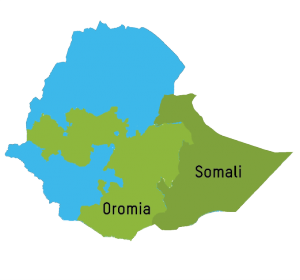Rural hub Ethiopia
Rural hub Ethiopia
Facts and figures

- Ethiopia is one of Africa's poorest nations, with half of its 77 million people currently living below the poverty line.
- More than 20 million young people, most of them in rural areas, have limited access to essential services and employment opportunities. This is especially the case for young women.
- Females account for more than 51.3% of the rural population in Oromia, and more than 47.9% in Somali, and women lack the capacity and assets to invest in agricultural and pastoral livestock productivity.
- Both the Somali and Oromia regions are affected severely by climate change and have high levels of youth unemployment due to landlessness and frequent drought and rural populations are scattered.
- A significant number of young Ethiopians are uneducated, landless, unemployed or underemployed.
- Work is found mostly in low-productivity, poorly remunerated and informal sectors.
- Youths lack appropriate skills and business orientation, while limited access to credit facilities hampers the self-employment opportunities, especially for young women.
- Most unemployed target youth are on the verge of migration to urban areas in search of any job even outside their areas of expertise.
“I’d like to contribute more to my mother and the younger children but I don’t have a job right now. At home I do most of the work, I go to the market, I fetch water. After I finish my school I want to help my community. And I want to earn money. Help my family. I don’t want to get married yet, I want to finish my studies first and set up my own business. Maybe after that I will get married. Also my mum doesn’t want me to marry now. First I have to settle my own life.” - Amanae Ababu Kader, 19 years old.
Topics for solutions
To make the rural hubs successful and sustainable for young people is a complex challenge. The Hubs need to become youth-friendly, provide tools to create job opportunities, and become a community space. E-Motive therefore looks into solutions for three broad topics:
- Decreasing of local production caused by climate treats and droughts
- Women and youth not seen as entrepreneurs
- The challenge of moving beyond traditional trainings
A first analysis of opportunities:
Abattoirs for animals, milk production, Cattle, sheep and Poultry, Flowers (export), Leather, textile and business adventure, Construction work. Setting up a lab for testing new technologies for agriculture (drought issues) and cooperation with universities, investors, cooperatives and local government.
